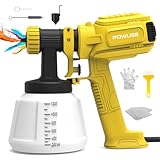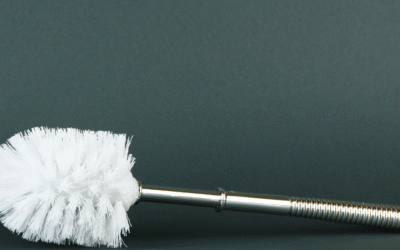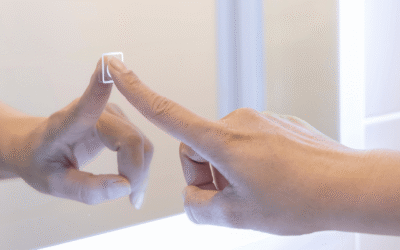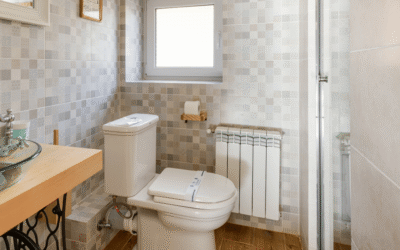Choosing the right paint sprayer can transform any painting endeavour, whether it’s a DIY project or a professional task. These tools offer speed and precision, allowing users to achieve a flawless finish with ease. Paint sprayers are indispensable for anyone who values efficiency and quality in their work. They enable users to cover large areas quickly, offering an even coat that dries faster than traditional methods.
However, not all paint sprayers are created equal. Each type, from airless to HVLP and pneumatic, comes with its own set of advantages and drawbacks. For instance, airless sprayers excel in handling thicker paints, making them ideal for exterior jobs, while HVLP sprayers are perfect for detailed work with water-based paints. Understanding these differences is crucial in selecting the best sprayer for your specific needs, ensuring a cleaner workspace and superior results.
Top Amazon Sellers
Key Takeaways
- Understanding Paint Sprayers: Different types of paint sprayers—such as airless, HVLP, and conventional—offer unique advantages tailored to specific painting tasks, enhancing both speed and precision.
- Type Selection: Choosing the right paint sprayer involves matching the sprayer type to your project’s requirements, with airless suitable for large areas and HVLP ideal for detailed work.
- Key Features: Consider essential features like nozzles, paint compatibility, and ease of use to optimise the performance and efficiency of your chosen paint sprayer.
- Application Techniques: Proper techniques, including practising on non-target surfaces and employing correct cleaning methods, are vital for achieving an even coat and extending the sprayer’s lifespan.
- Budget and Brand Considerations: Evaluate your budget and research reputable brands to balance cost-effectiveness with reliability, ensuring a worthwhile investment in your paint sprayer.
Types of Paint Sprayers
Selecting the best paint sprayers involves understanding the various types available. Each type offers unique features suited for different applications, ensuring tasks are completed efficiently and effectively.
Conventional Sprayers
Conventional sprayers utilise compressed air to atomise paint, delivering a smooth finish. They’re versatile and handle multiple paint viscosities, making them suitable for general use. However, these sprayers tend to waste more paint due to higher overspray and may require more frequent maintenance.
High Volume Low-Pressure (HVLP) Sprayers
HVLP sprayers use low pressure for precise paint application, reducing overspray. They’re ideal for detailed projects like trim or furniture, providing smooth and even coverage. Though they can’t efficiently handle thicker paints, thinning the paint can mitigate this limitation, enhancing their performance.
Airless Sprayers
Airless sprayers operate using high pressure to atomise paint, making them perfect for large surfaces like ceilings or walls. They work well with thicker coatings and excel in covering extensive areas quickly. Despite their efficiency, airless sprayers may result in higher overspray and need careful handling for best results.
Features to Consider
Selecting the best paint sprayers depends on various factors, including nozzles, paint compatibility, and usability.
Nozzles and Tips
Nozzles and tips significantly impact sprayer performance. Choosing the correct size and type ensures optimal coverage and minimal overspray. Many airless paint sprayers come with a standard size, but additional tips can be purchased. Verify the manufacturer’s chart for compatibility with your chosen model.
Paint Compatibility
Paint compatibility is crucial for achieving a smooth finish. Ensure the sprayer can handle the specific paint type intended for use. Some sprayers work better with thin paints, while others accommodate thicker formulations. Check specifications to match the sprayer with suitable materials.
Ease of Use
Ease of use enhances painting efficiency and comfort. Features like adjustable settings, ergonomic design, and a lightweight build contribute to user-friendly operation. Sprayers should be simple to assemble, operate, and clean to reduce fatigue and maintain productivity during extensive projects.
Tips for Using a Paint Sprayer
Leveraging a paint sprayer enhances application speed and precision. To maximise results, follow these essential tips.
Practise on Surfaces
Practicing on surfaces like cardboard or plywood refines technique before tackling main projects. Experiment with nozzle adjustments and spray patterns to determine optimal settings. Mastering this control delivers the best paint sprayers’ finish quality.
Proper Cleaning Techniques
Regular cleaning techniques prevent nozzle clogs and maintain sprayer efficiency. For water-based paints, rinse promptly after use to avoid drying, while oil-based paints require solvent cleaning. A clean sprayer ensures consistent performance and longevity.
Avoiding Overspray
Overspray minimises by adjusting pressure settings and using appropriate spray tips. Protect non-target areas with dust sheets and masking materials. Adequate setup provides clean, accurate application without unwanted paint distribution.
Choosing the Right Paint Sprayer
Selecting the right paint sprayer determines the success of your painting project. Understanding the aspects of your project helps ensure optimal results and satisfaction.
Project Requirements
Consider the size and type of surfaces to be painted. Large areas benefit from airless sprayers due to their speed, while detailed work favours HVLP sprayers for precision and less overspray. The chosen sprayer type impacts the quality of the finish, with project specifics guiding the decision.
Budget Considerations
Evaluate the price range that fits your budget without compromising on essential features. Entry-level models suit occasional users, offering simplicity at a lower cost, whereas professionals might invest in advanced models with durable construction and versatile settings. Balancing cost with functionality ensures value in your purchase.
Brand Reputation
Research user feedback and expert reviews to gauge a brand’s standing. Established brands often provide reliability and support, ensuring users receive efficient performance and after-sales assistance. Opt for manufacturers with positive reputations to guarantee long-term satisfaction with your sprayer investment.
Prepping Your Painting Area
Prepping the painting area is crucial when using the best paint sprayers. Begin by ensuring the room is well-ventilated; open windows and use air purifiers to reduce inhalation risks. Cover surfaces not being painted with dust sheets and masking materials to protect against overspray, as paint particles can travel and settle on unintended areas. Safety gear is essential: wear N95 masks and protective eyewear to shield against paint inhalation and eye irritation. Test paint consistency by mixing it correctly; this often requires diluting with water. Use cardboard to practise spraying techniques and setting adjustments. Thoroughly secure tarps along walls and floors to guard against paint splatter. Take time to prepare meticulously to ensure a clean, efficient painting process.
Conclusion and Top Picks
Choosing the right paint sprayer transforms painting projects by enhancing speed and precision while ensuring a flawless finish. By understanding the distinct features of airless, HVLP, and pneumatic sprayers, users can select the most suitable tool for their specific needs. Key considerations such as nozzle size, paint compatibility, and ease of use significantly influence the efficiency and effectiveness of the painting process. Additionally, proper preparation and technique refinement are essential for achieving professional results. Investing in a quality paint sprayer tailored to project requirements and budget ensures a clean, efficient, and satisfying painting experience.
Frequently Asked Questions
What is the main benefit of using a paint sprayer?
Using a paint sprayer significantly increases speed and precision for both DIY and professional painting projects. Sprayers deliver a flawless finish, making them ideal for large areas or detailed work. Moreover, they minimise brush marks, providing an even coat quickly while reducing the effort involved.
How do airless paint sprayers differ from HVLP sprayers?
Airless paint sprayers use high pressure to apply paint efficiently over large surfaces, ideal for exterior walls or fences, but require careful handling to mitigate overspray. In contrast, HVLP (High Volume Low Pressure) sprayers operate at lower pressure, making them perfect for detailed work with less paint waste, although they may need paint thinning for thicker formulations.
What should you consider when choosing a paint sprayer?
When selecting a paint sprayer, consider the type of projects you plan to undertake, the sprayer’s nozzle and tip compatibility, paint types you’ll use, and ease of use. Look for adjustable settings, ergonomic design, and lightweight construction to ensure comfort and efficiency. It’s also important to align your choice with your budget and the brand’s reputation for reliability.
Why is it crucial to prep the painting area before using a sprayer?
Prepping ensures a clean, efficient painting process. Proper ventilation, covering non-target surfaces with dust sheets, and wearing protective gear prevent mishaps. Testing paint consistency and practising spraying on cardboard help refine skills, while securing tarps protects against splatter, ensuring a professional finish without damage to surroundings.
How can you minimise overspray when using a paint sprayer?
To minimise overspray, adjust the sprayer’s pressure settings, select appropriate spray tips, and cover non-paint areas with dust sheets and masking materials. Practicing on spare surfaces helps fine-tune technique while ensuring clean and accurate paint application during the actual painting process.
Is it necessary to thin all paints for spraying?
Not all paints require thinning. However, thicker paints, like latex, may clog sprayers, particularly HVLP models. Thin the paint by mixing a half cup of water per gallon of paint and stirring thoroughly to achieve a suitable consistency for effective spraying.
What can cause issues when using a paint sprayer?
Common issues include mismatched colours, ignoring instructions, failing to prep surfaces, and inadequate drying time. Applying thick coats, not adjusting spray pressure, and using inappropriate spray tips can lead to overspray and uneven finishes. Proper planning and technique adjustment can help avoid these pitfalls.












